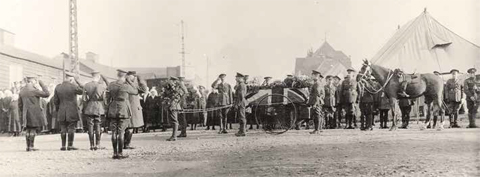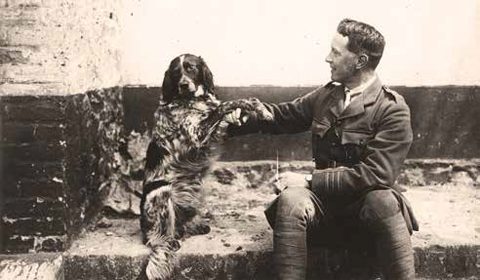Thanks to a best-selling book, hit play and Hollywood movie, millions know the tale War Horse, a fictionalized account of the important and dangerous role horses played in the First World War. Millions of animals, including horses, mules, dogs, pigeons and even glow-worms served on both sides of the conflict. These animal soldiers transported troops and supplies, carried the wounded, detected poisonous gas, hunted rats, delivered messages and offered comfort and companionship to homesick soldiers. And the glow-worms? They were piled into glass jars and provided dim light in the trenches for men to read letters, maps and reports.
In the heat of battle and through the long periods of inactivity, soldiers formed intense bonds with their animals. Lieutenant-Colonel John McCrae, known to millions as the author of the war poem “In Flanders Fields,” brought his horse Bonfire with him when he shipped overseas to serve as a field surgeon.
McCrae (BA 1894 UC, MD 1910) wrote: “I have a very deep affection for Bonfire, for we have been through so much together, and some of it bad enough. All the hard spots to which one’s memory turns the old fellow has shared, though he says so little about it.”
This tenderness spilled over into correspondence. Charming letters from Bonfire to McCrae’s nieces and nephews back in Canada were signed with his hoof:
August 6th, 1916
Did you ever have a sore hock? I have one now. . . I am glad you got my picture. My master is well, and the girls tell me I am looking well, too. The ones I like best give me biscuits and sugar, and sometimes flowers… Another one sends me bags of carrots. If you don’t know how to eat carrots, tops and all, you had better learn, but I suppose you are just a boy, and do not know how good oats are.
—Bonfire (signed with a horseshoe)
McCrae also befriended at least two dogs while overseas. Mike, a one-eyed terrier, and Bonneau, who accompanied him on patient rounds. The fate of Mike and Bonneau isn’t known. Sadly, McCrae died of pneumonia and meningitis in January of 1918. Bonfire, who survived the war, led McCrae’s funeral procession, McCrae’s boots reversed in his stirrups.

Recent Posts
For Greener Buildings, We Need to Rethink How We Construct Them
To meet its pledge to be carbon neutral by 2050, Canada needs to cut emissions from the construction industry. Architecture prof Kelly Doran has ideas
U of T’s 197th Birthday Quiz
Test your knowledge of all things U of T in honour of the university’s 197th anniversary on March 15!
Are Cold Plunges Good for You?
Research suggests they are, in three ways






One Response to “ Animals, the Forgotten Warriors ”
Thank you for the info about John McRae M.D. As a public school student growing up in Toronto, we all had to recite “In Flanders Field” every Nov.11. At 84, I still remember the words and do not hesitate to remind my American Colleagues on Nov.11…He truly lives on with his poetry.
Sincerely,
M.M.Bocknek, M.D. U/T Meds 5T4
Springfield, Virginia.